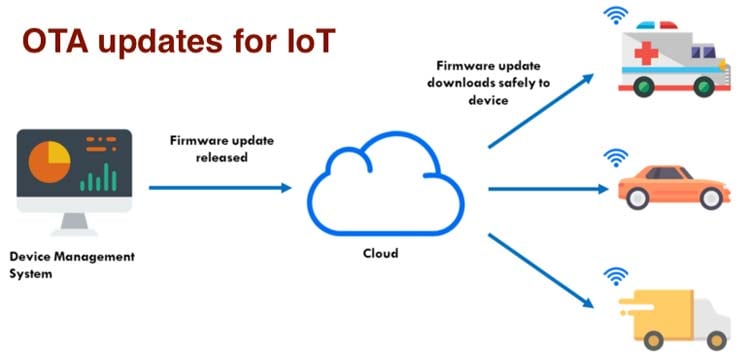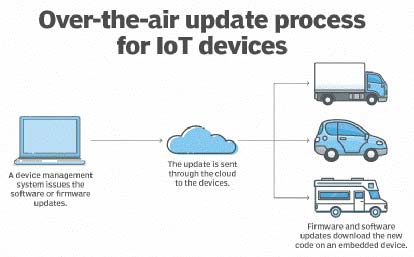
During the initial phase, the Internet of Things (IoT) was not that charismatic and modernized because, during that time when a remote device required firmware update, there were numerous technological disruptions, performance impact, and compute or reckon with downtime. Apart from this, a diminutive alteration required human involvement and in the majority of cases, on-site people are needed to monitor the problems and they had to ensure that the changes are not troubling the entire system. The device that requires software updates needs to be extracted and even knockdown if the situation demands it. Manual works are needed even if you are running scores of connected devices or unleash an update to a particular device group. Challenges arise when devices at several sites require updating or at extremely far-off areas. In these scenarios, organizations have two choices: their systems can be crafted for deploying over-the-air(OTA) updates or to purchase an already available cutting-edge OTA solution.
Now, as the world is now moving towards 5G, the growth of IoT has been escalating tremendously where billions of new-fangled devices will be connected. In the age of innovation and development of top-notch technology, OTA updates are mandatory as experts opine. Now, the point is why it has become so imperative? The technology which is there in OTA basically remains unchanged, but the augmenting volumes of connected devices uplift the requirement for a sophisticated IoT OTA podium and increase its use cases. Over the past twenty years, OTA solutions and platforms have played a pivotal role in the telecommunications sector. For instance, inside the mobile phone, SIM cards act as a mini-computer as it has all the important configuration files and credentials that helps the product to operate seamlessly both in terms of connectivity and security. Since the time of 2G, the solution is helping the sector.

The OTA helps operators to unleash a new SIM or help them alter their SIM card’s content swiftly and in a cost-effective manner. This platform is plotted on service or client architecture where there is an operator back-end system like application server, customer billing, and billing system and also there is a SIM card on the other hand. The back-end system then provides service requests to the OTA platform, which after changing it into small messages forwards them onto a short message service center, thereby transmitting them to numerous SIM cards in the area.
Escalation of 5G and IoT Devices Requires OTA Podiums
With the onset of ignition of the IoT devices, the policies for the longevity of communicating products will turn out to be a huge impediment and most of these products like infrastructure machinery or smart meters deployed in smart cities will try hard to get connected to the corresponding networking providers despite being unsubscribed from the service. It will ultimately craft a huge unwarranted pressure on the networks. Now, with the deployment of the OTA solution, this constant communication via connectivity can be restricted or completely ward off.
As various kinds of IoT devices are on the rise, a new way of updating methods is essential. Previously, updates to each device were dispatched by mobile operators through SMS. For instance, a generator that is connected might not get an SMS, and hence, the IoT OTA podium depends on data connectivity to direct updates through the means of HTTP. In the case of an electric meter, which does not entail a mobile number, OTA updates are sent by utilizing the device International Mobile Subscriber Identity (IMSI). Another example is when many of the IoT devices are not connected or offline for a longer time, this OTA dais has the potential to detect when the offline products again connect to the network and send updates.
Pierre Barrial, CEO, IDEMIA, said "the IoT OTA podium also crafts the possibility of new applications. For example, the imperative development is the GSMA IoT Security and Freedom Through Encryption (SAFE) applet, which aims to provide complete security protection to all bi-directional communications coupled with IoT products both device-to-device and device-to-cloud. Most importantly, the platform also helps OEMs and mobile operators to supervise customer service’s quality like data accessibility, quality of coverage, the reasons for dropped calls, and constantly supervising the network access technology.”
“It will ultimately assist the operators to utilize this source of data for reconfiguration SIM cards Over-The-Air and maintenance of their networks. There are also numerous hurdles in connectivity, which is also countered by OTA platforms like many developed and developing countries are trying hard to deploy always-on connectivity for emergency services that can be met via the updates of radio policy files, which can be further updated through OTA. Nowadays, LTE/5G private networks of defense industries such as military, police, air, and land are crafted with their in-built eSIM, SIM, and multi-IMSI where OTA updates can help in reconfiguring the cards seamlessly so that the connected devices always attach to the sophisticated networks,” added Barrial.
There are numerous challenges while testing an OTA platform or solution, mostly on the measurement aspect. One of the hurdles centering the antenna system. As the technology is getting more advanced and pushing towards the 5G ecosystem, discovering an impeccable position and set-up for a 3D antenna to examine the moving beams while accounting for scattering and interference will be intricate. There must be an inclusion of a new-fangled measurement of proportions like power or space versus the departure’s direction. While testing an OTA, phantoms are utilized and therefore it is important to note that all the devices must look for the blocking effect on the body of humans on the radiation pattern. Another barrier is that in the active antenna systems there are several transceivers located and each of them has to be characterized by the OTA interface, with measurements crafted for the receiver as well as the transmitter. It is mandatory that the transceiver must be turned on for joint evaluation or individual verification.

The Usefulness of OTA Updates for IoT Podiums
Experts claim that if any organization or individuation wants to stay ahead of the curve in developing their IoT-based products then having OTA capability is a must. Nowadays, OTA deployments and updates have become very customary and many of these platforms appear with basic or elementary functionality that relates to OTA updates. Now, the potential to examine new software directly on the product, supervise processes remotely, or push for updates over the air from within a single area has turned out to be crucial to swift IoT development.
If the IoT podium landscape is matured, the process of controlling and supervising the connected products remotely becomes more trailblazing. Similar to testing remotely, OTA updates help you adjust codes on any embedded product and also help you discover the alterations seamlessly. Most of the IoT platforms are now based on hardware, and therefore the specific hardware people utilizing are turning to be less pertinent. People can now connect any product and craft any machine IoT-enabled. While making an IoT product, the OTA updates do not stop and once users begin using the finished product, software updates can be dispatched via over the air, which means you can constantly fix the bigs and alter the behavior of the product as per requirements. Also, more features and benefits can be added and in this way, you can maintain your relationships with end-users impeccably by installing innovative functionalities remotely.
For a rapid IoT development scenario, the potential for running OTA updates via an IoT podium makes the process swift, which makes the connected products more reliable and protects transparency. Until now, it has proven to be the most effective way to push updates on smart devices available remotely and at the same time, it documents every step of the procedure. Any equipment can be furnished with sensors and connected to the dais, which ultimately helps in providing accurate alerts and status of maintenance. The OTA platform also aids in keeping track of the assets like from a lone location every connected product can be tracked and in addition, security updates can be taken care of. Moreover, supply chain management can be observed in real-time and optimized whenever required. This platform can be even utilized in several environmental, agriculture, and waste management applications.





